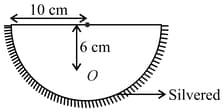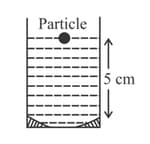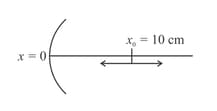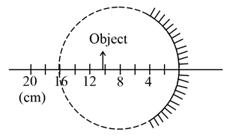Assertion: Magnification produced by a convex mirror is always positive, but that by a concave mirror may be both positive and negative.
Reason: Based on sign convention, magnification can be positive or negative.
Important Questions on Light- Reflection and Refraction
A hemispherical glass body of radius 10 cm and refractive index 1.5 is silvered on its curved surface. A small air bubble is 6 cm below the flat surface inside it along the axis. The position of the image of the air bubble made by the mirror is seen :


A point object is moving uniformly towards the pole of a concave mirror of focal length along its axis as shown below. The speed of the object is . At , the distance of the object from the mirror is . The average velocity of the image formed by the mirror between time and is:

| Object pin | Convex Lens | Convex Mirror | Image Pin |
| 22.2 cm | 32.2 cm | 45.8 cm | 71.2 cm |
A particle is oscillating on the -axis with an amplitude about the point with a frequency. A concave mirror of focal length is placed at the origin (see figure).

Identify the correct statements?
(i) The image executes periodic motion.
(ii) The image executes non-periodic motion.
(iii) The turning points of the image are asymmetric with respect to the image of the point at .
(iv) The distance between the turning points of the oscillation of the image is .
A spherical mirror is obtained as shown in the figure from a hollow glass sphere, if an object is positioned in front of the mirror, what will be the nature and magnification of the image of the object? (Figure down as schematic and not to scale)

(Graphs are drawn schematically and are not to scale)
| Column 1 | Column 2 | ||
| (A) | (a) | Convex mirror | |
| (B) | (b) | Concave mirror | |
| (C) | (c) | Real image | |
| (D) | (d) | Virtual image |

